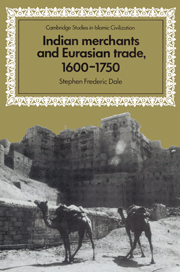Book contents
- Frontmatter
- Contents
- List of illustrations
- Preface
- Note on transliteration
- Abbreviations
- 1 An Indian world economy
- 2 India, Iran and Turan in 1600
- 3 The Indian diaspora in Iran and Turan
- 4 Indo-Russian commerce in the early modern era
- 5 The Indian diaspora in the Volga basin
- 6 Imperial collapse, mercantilism and the Mughul diaspora
- Appendix
- Bibliography
- Index
4 - Indo-Russian commerce in the early modern era
Published online by Cambridge University Press: 22 September 2009
- Frontmatter
- Contents
- List of illustrations
- Preface
- Note on transliteration
- Abbreviations
- 1 An Indian world economy
- 2 India, Iran and Turan in 1600
- 3 The Indian diaspora in Iran and Turan
- 4 Indo-Russian commerce in the early modern era
- 5 The Indian diaspora in the Volga basin
- 6 Imperial collapse, mercantilism and the Mughul diaspora
- Appendix
- Bibliography
- Index
Summary
And these merchants and ambassadors are given leave to go to India … And when they arrive at the first Indian town they should tell its ruler that they are ambassadors of the great Tsar and great prince, Aleksei Mikhailovich, autocrat of all the Russias and ruler of many states, to their ruler, his majesty Shah Jahan.
Instructions to the first Russian embassy to India, June, 1646.Russian annexation of the Astrakhan khanate in 1556 gave the expanding Muscovite state a vital “window on the East,” and for more than a century and a half the port of Astrakhan, located on the Volga's Caspian estuary, functioned as one of Russia's two most important links with the outside world. The other was the port of Archangel in the Russian arctic. Russian officials and merchants sought to use Astrakhan to gain direct access to Asian products to augment the state's customs revenue and to acquire silver for its currency. They tried to achieve these goals by inviting Indian and other Asian merchants to settle and trade in the city as well as through the dispatch of commercial-diplomatic missions to the Mughul court, along with others that were sent to Iran and the Uzbek khanates of Turan. In so far as their relations with Indians were concerned Russian governments were only moderately successful in attaining their economic goals.
- Type
- Chapter
- Information
- Indian Merchants and Eurasian Trade, 1600–1750 , pp. 78 - 100Publisher: Cambridge University PressPrint publication year: 1994



